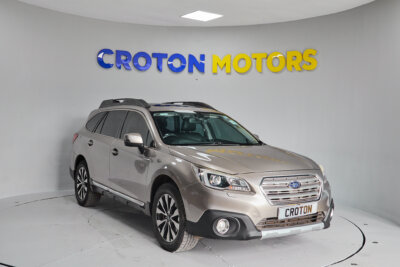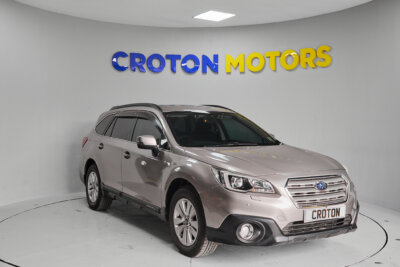Subaru Outback for sale in Kenya
What would you like to do?
Subaru Outback in stock now
Try changing your search parameters.
About the Subaru Outback
1. Brand & Model Introduction
- The Subaru Outback is a versatile crossover SUV that blends comfort, rugged capability, and refined design. In the Kenyan car market, it’s loved for its all-terrain ability, spacious interior, and reliability on both city roads and rural terrain.
2. Trims or Variants Available
- Popular trims in Kenya include:
- Outback 2.5i Base – Standard features and AWD capability.
- Outback 2.5i Premium – Adds comfort upgrades like heated seats and larger infotainment screen.
- Outback 2.5i Limited – Leather upholstery, advanced safety features, premium audio.
- Outback XT/3.6R – Higher performance versions with turbocharged or 3.6L engines, suitable for enthusiasts.
- These trims differ in interior sophistication, safety technologies, and engine power – all while maintaining Subaru’s core reliability and off-road readiness.
3. Engine Sizes & Drive Trains
- Engine options in the Kenyan market include:
- 2.5L Petrol, AWD
- 2.4L Turbo Petrol, AWD (XT trim)
- 3.6L Petrol, AWD (3.6R trim)
- All Outback models offer All-Wheel Drive (AWD), ideal for Kenya’s mixed terrain.
4. Fuel Consumption Rates
- Fuel consumption under mixed driving conditions:
- 2.5L models: Approx. 12–14 km/l
- 3.6L models: Approx. 9–11 km/l
- 2.4L Turbo: Approx. 11–13 km/l
- Good fuel efficiency in Kenya, especially for highway trips and light off-roading.
5. Interior Features
- Features include:
- Spacious cabin with premium fabric or leather seats
- Dual-zone climate control
- 8–11.6″ touchscreen infotainment with Android Auto & Apple CarPlay
- Ample legroom and rear cargo space
- Ideal for family trips and long commutes across Kenyan counties.
6. Exterior Features
- Key highlights:
- Raised ground clearance of approx. 213mm – perfect for rural and rough roads
- Roof rails for luggage/cargo
- LED headlights and alloy wheels
- Wagon-style body with rugged plastic cladding
7. Safety Features & Precautions
- Safety tech includes:
- Subaru’s EyeSight Driver Assist Technology
- ABS, multiple airbags, lane departure warning, adaptive cruise control
- Rearview camera and blind-spot monitoring
- Excellent reputation for keeping occupants safe on unpredictable Kenyan roads.
8. Reliability & Maintenance
- Widely known as one of the most reliable cars in Kenya.
- Easy to maintain with regular service; Subaru mechanics and garages are well-established in most major towns.
9. Resale Value in Kenya
- The Subaru Outback resale value Kenya market is strong, particularly for models with low mileage and full service history.
- Retains value better than many rivals in its class due to reliability and versatility.
10. Spare Parts Availability in Kenya
- Subaru Outback spare parts in Kenya are widely available.
- Genuine and aftermarket parts accessible through Subaru dealers and independent suppliers in Nairobi, Mombasa, Kisumu, and other towns.
- Maintenance costs are generally affordable.
11. Target Buyer – Who is This Car For?
- Perfect for families, adventure-seekers, and professionals who want a rugged-yet-comfortable SUV with strong fuel efficiency in Kenya.
- Great for those commuting in Nairobi and frequently traveling upcountry.
What is the price of Subaru Outback in Kenya?
Prices of locally used Subaru Outback in Kenya will range from as low as KES 2,600,000 to around KES 6,300,000 for new models. Below is a price guide of newly imported Subaru Outback in Nairobi and Mombasa.
| Model Year | Price |
|---|---|
| 2014 | KES 2,600,000 ~ 3,200,000 |
| 2015 | KES 2,900,000 ~ 3,500,000 |
| 2016 | KES 3,200,000 ~ 4,000,000 |
| 2017 | KES 3,700,000 ~ 4,700,000 |
| 2018 | KES 4,200,000 ~ 5,000,000 |
| 2019 | KES 4,900,000 ~ 5,800,000 |
| 2020 | KES 5,300,000 ~ 5,900,000 |
| 2021 | KES 5,600,000 ~ 6,300,000 |
Are you looking at buying new or used Subaru Outback in Kenya? Are you looking at selling your used Subaru Outback in Kenya? Do you want to know the prices of new or used Subaru Outback in Kenya? Do you want to know how to import Subaru Outback from Japan? Please visit our show room in Karen, Nairobi and our sales agents will guide you.
Below is a list of Subaru Outback for sale in Nairobi, Kenya and also others available in Japan. You can now buy and import year 2025, 2024, 2023, 2022, 2021, 2020, 2019, and 2018 Subaru Outback from Japan to Kenya.
Subaru Outback Videos
- 2018 Subaru Outback – Review and Road TestLoading Video
- Should I buy the 2019 Outback or the 2019 ForesterLoading Video
- Subaru Outback 4x4 reviewLoading Video
- 2017 Subaru Outback - Review and Road TestLoading Video
- 2019 Outback Accessory HighlightsLoading Video






